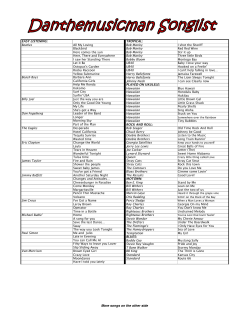
5 Essential Jazz Guitar Scale Patterns
5 Essential Jazz Guitar Scale Patterns www.mattwarnockguitar.com When developing our jazz guitar technique in the practice room, many of us will learn and practice jazz guitar scale patterns over different modes and in all 12 keys on the fretboard. While we know that it is important to work on jazz guitar scale patterns to build our technique and expand our soloing vocabulary, sometimes we aren’t sure which patterns we should be practicing in order to get the most out of our time in the woodshed. To help organize your jazz guitar scale patterns in the woodshed, I have put together 5 essential jazz guitar scale patterns that every player should learn at one point or another in their development. Each of these patterns can be applied to one, two and three-octave scale shapes, as well as to any scale or mode in any key on the fretboard. Using these jazz guitar scale patterns will not only increase your technique, and control over various modes on the guitar, but they are commonly used soloing patterns which will increase your jazz guitar soloing chops at the same time. If you want to learn jazz guitar scales and jazz guitar scale patterns from your iPad or iPhone, check out the “Matt Warnock Guitar Jazz Guitar Scales App.” Jazz Guitar Scale Patterns - Practice Variations As you will notice, all of the jazz guitar scale patterns in this lesson are written out with four different variations. This will give you enough variety to keep things interesting in the woodshed, as well as give you more variations when applying these patterns to your soloing ideas. Here are the 4 different approaches used in this lesson for all of the jazz guitar scale patterns. Feel free to start with one per chord, then build up to all 4 from there. 1. All Ascending 2. All Descending 3. One Ascending and One Descending 4. One Descending and One Ascending For 100s of more FREE Jazz Guitar Lessons Visit www.mattwarnockguitar.com How to Practice Jazz Guitar Scale Patterns To help get you started with these jazz guitar scale patterns, here are 10 ways that I like to practice these ideas in the woodshed. 1. Work on any pattern with a metronome in one key from 30 to 200 bpm if possible. 2. Apply any pattern to 2 and 3-octave jazz guitar scale fingerings 3. Add various jazz guitar accent patterns to any scale pattern over a given scale 4. Vary the rhythm by exploring important jazz guitar rhythms such as quarter notes, 8th notes, triplets, 16th notes and the Charleston rhythm 5. Work any of the above exercises through various modes of the Major, Melodic Minor, Harmonic Minor, Symmetrical and Harmonic Major Scales 6. Practice any of the above exercises in all 12 keys around the fretboard 7. Put on a one-chord or one-key jazz guitar backing track and use any pattern as the basis for your improvised lines and phrases 8. Solo over ii-V-I jazz guitar chord progressions in various keys using any of these patterns as the basis for your lines over those chords 9. Improvise over a jazz blues chord progression, using any of these patterns to build your soloing lines and licks 10.Put on a Jazz Guitar Standard backing track and solo over the tune with one or more of these patterns included in your lines and phrases Jazz Guitar Scales Pattern 1 - 123 The first scale pattern that we will learn uses a 3-note sequence, 123, that then climbs the scale as such, 123-234-345, etc. Here are the four variations of this pattern written out over a C major scale. 123 Ascending Click to hear audio for this jazz guitar scale pattern. For 100s of more FREE Jazz Guitar Lessons Visit www.mattwarnockguitar.com 123 Descending Click to hear audio for this jazz guitar scale pattern. 123 Alternating 1 Click to hear audio for this jazz guitar scale pattern. 123 Alternating 2 Click to hear audio for this jazz guitar scale pattern. For 100s of more FREE Jazz Guitar Lessons Visit www.mattwarnockguitar.com Jazz Guitar Scale Pattern 2 - 4th Intervals The second jazz guitar scale pattern that we’ll look at uses a modern-sounding sequence, 4th intervals. 4ths are a great way to bring a modern sound to your jazz-guitar solos, and since many Perfect 4ths can be played with one finger on the fretboard, these are usually quick and easy to get under your fingers and bring into your soloing ideas. Again, there are four variations of this jazz guitar scale pattern, so begin with the all ascending version and work your way onto the other three variations from there. 4ths Ascending Click to hear audio for this jazz guitar scale pattern. 4ths Descending Click to hear audio for this jazz guitar scale pattern. For 100s of more FREE Jazz Guitar Lessons Visit www.mattwarnockguitar.com 4ths Alternating 1 Click to hear audio for this jazz guitar scale pattern. 4ths Alternating 2 Click to hear audio for this jazz guitar scale pattern. Jazz Guitar Scale Patterns 3 - Triads The third pattern that we’ll look at uses diatonic triads to outline any given scale that you are working on in the woodshed. One thing to notice with this pattern, is that when applied to 8th-notes, the three-note triad creates a neat-sounding syncopation, where you are beginning each triad on a different part of the bar as you work up and down the scale. Varied rhythms such as these are a great way to build intensity and energy when applying jazz guitar scale patterns to your improvised solos. For 100s of more FREE Jazz Guitar Lessons Visit www.mattwarnockguitar.com Triads Ascending Click to hear audio for this jazz guitar scale pattern. Triads Descending Click to hear audio for this jazz guitar scale pattern. For 100s of more FREE Jazz Guitar Lessons Visit www.mattwarnockguitar.com Triads Alternating 1 Click to hear audio for this jazz guitar scale pattern. Triads Alternating 2 Click to hear audio for this jazz guitar scale pattern. For 100s of more FREE Jazz Guitar Lessons Visit www.mattwarnockguitar.com Jazz Guitar Scale Patterns 4 - Arpeggios The next in our series of jazz guitar patterns uses 4-note diatonic arpeggios to outline any given scale, in this case a C major scale. Though they are only extended by one note from the triads in the previous example, arpeggios can be tricky to get under your fingers when running them through any given jazz guitar scale. Because of this, be sure to start slow and always work with a metronome when running arpeggios through any scale you are working on in the practice room. Have smooth, even and accurate rhythms is key to successfully running arpeggios through a technical workout or when applying them to an improvisational context. Arpeggios Ascending Click to hear audio for this jazz guitar scale pattern. For 100s of more FREE Jazz Guitar Lessons Visit www.mattwarnockguitar.com Arpeggios Descending Click to hear audio for this jazz guitar scale pattern. Arpeggios Alternating 1 Click to hear audio for this jazz guitar scale pattern. For 100s of more FREE Jazz Guitar Lessons Visit www.mattwarnockguitar.com Arpeggios Alternating 2 Click to hear audio for this jazz guitar scale pattern. Jazz Guitar Scale Pattern 5 - 1235 The last scale pattern that we’ll learn in today’s lesson looks at the 1235 sequence, which was made famous by John Coltrane’s improvised solo on the tune Giant Steps. The pattern runs the 12345 intervals starting on each note in the scale, so you can think of it as a triad with one extra note, the 2, giving it a sound that is somewhere between the triad and 123 scale pattern. Learning this pattern is considered essential by many jazz educators, myself included, and so I strongly recommend spending time with this pattern in both your technical and improvisational practice sessions. For 100s of more FREE Jazz Guitar Lessons Visit www.mattwarnockguitar.com 1235 Ascending Click to hear audio for this jazz guitar scale pattern. 1235 Descending Click to hear audio for this jazz guitar scale pattern. For 100s of more FREE Jazz Guitar Lessons Visit www.mattwarnockguitar.com 1235 Alternating 1 Click to hear audio for this jazz guitar scale pattern. 1235 Alternating 2 Click to hear audio for this jazz guitar scale pattern. For 100s of more FREE Jazz Guitar Lessons Visit www.mattwarnockguitar.com Do you have a question or comment about these 5 essential jazz guitar scale patterns? Visit the Matt Warnock Guitar Facebook Page and post your question on my wall, be happy to help you out. For 100s of more FREE Jazz Guitar Lessons Visit www.mattwarnockguitar.com
© Copyright 2025












